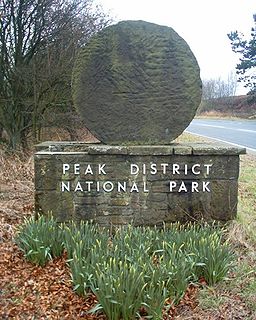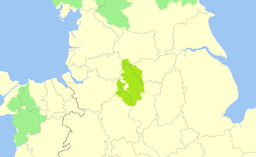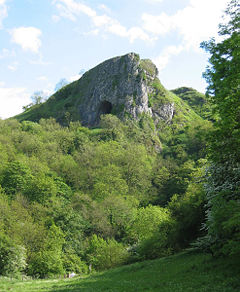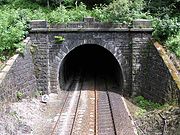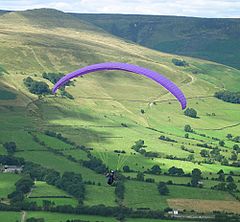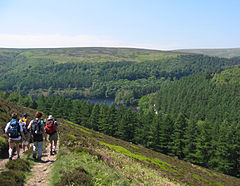
Peak District
Did you know...
Arranging a Wikipedia selection for schools in the developing world without internet was an initiative by SOS Children. Click here for more information on SOS Children.
| Peak District | |
| Protected Area | |
|
Peak District entrance stone on Hathersage Road, Sheffield
|
|
| Country | England |
|---|---|
| Counties | Derbyshire, Cheshire, Greater Manchester, Staffordshire, South Yorkshire, West Yorkshire |
| Highest point | |
| - location | Kinder Scout |
| - elevation | 2,087 ft (636 m) |
| Area | 555 sq mi (1,437 km2) |
| National parks of England and Wales | 1951 |
| IUCN category | V - Protected Landscape/Seascape |
| Website: www.peakdistrict.gov.uk | |
The Peak District is an upland area in central and northern England, lying mainly in northern Derbyshire, but also covering parts of Cheshire, Greater Manchester, Staffordshire, and South and West Yorkshire.
Most of the area falls within the Peak District National Park, whose designation in 1951 made it the earliest national park in the British Isles. An area of great diversity, it is conventionally split into the northern Dark Peak, where most of the moorland is found and whose geology is gritstone, and the southern White Peak, where most of the population lives and where the geology is mainly limestone-based. Proximity to the major conurbations of the North East Midlands, Yorkshire, Lancashire and Greater Manchester, coupled with easy access by road and rail, have all contributed to its popularity. With an estimated 22 million visitors per year, the Peak District is thought to be the second most-visited national park in the world (after the Mount Fuji National Park in Japan).
Geography
The Peak District forms the southern end of the Pennines and much of the area is uplands above 1,000 feet (300 m), with a high point on Kinder Scout of 2,087 feet (636 m). Despite its name, the landscape lacks sharp peaks, being characterised by rounded hills and gritstone escarpments (the "edges"). The area is surrounded by major conurbations, including Huddersfield, Manchester, Sheffield, Derby and Stoke-on-Trent.
The National Park covers 555 square miles (1,438 km²) of Derbyshire, Staffordshire, Cheshire, Greater Manchester and South and West Yorkshire, including the majority of the area commonly referred to as the Peak. The Park boundaries were drawn to exclude large built-up areas and industrial sites from the park; in particular, the town of Buxton and the adjacent quarries are located at the end of the Peak Dale corridor, surrounded on three sides by the Park. The town of Bakewell and numerous villages are, however, included within the boundaries, as is much of the (non-industrial) west of Sheffield. As of 2006, it is the fourth largest National Park in England and Wales. As always in Britain, the designation "National Park" means that there are planning restrictions to protect the area from inappropriate development, and a Park Authority to look after it - but does not imply that the land is owned by the government, or is uninhabited.
12% of the Peak District National Park is owned by the National Trust, a charity which aims to conserve historic and natural landscapes. It does not receive government funding. The three Trust estates ( High Peak, South Peak and Longshaw) include the ecologically or geologically significant areas of Bleaklow, Derwent Edge, Hope Woodlands, Kinder Scout, Leek and Manifold, Mam Tor, Dovedale, Milldale and Winnats. The Peak District National Park Authority directly owns around 5%, and other major landowners include several water companies.
Geology
Much of the Peak District, and its adjacent areas, approximate to the structure of an eroded dome. The Carboniferous Coal Measures lie just outside the district, especially on the eastern side. Below the Coal Measures are the shales and sandstones of the Millstone Grit. The grit forms the moorland of the Dark Peak, and also extends in two ridges southwards on the west and east sides of the district. The shales occur at the base of the grit.
Between the two gritstone ridges, the underlying early Carboniferous Limestone is at the surface, forming the centre of the dome. This is the White Peak. The limestone produces numerous caves – this is sometimes known as karst topography.
The Peak District dome is at the south end of the Pennine anticline.
For a detailed description of the geology of the area see Cope's monograph.
Ecology
The gritstone and shale of the Dark Peak supports heather moorland and blanket bog environments, with rough sheep pasture and grouse shooting being the main land uses. The limestone plateaus of the White Peak are more intensively farmed, with mainly dairy usage of improved pastures. Some sources also recognise the South West Peak (near Macclesfield) as a third type of area, with intermediate characteristics.
Woodland forms around 8% of the Peak National Park. Natural broadleaved woodland is found in the steep-sided, narrow dales of the White Peak and the deep cloughs of the Dark Peak, while reservoir margins often have coniferous plantations.
Lead rakes
Economy
Tourism is the major local employment for Park residents (24%), with manufacturing industries (19%) and quarrying (12%) also being important; only 12% are employed in agriculture. The cement works at Hope is the largest employer within the Park. Tourism is estimated to provide 500 full-time jobs, 350 part-time jobs and 100 seasonal jobs. There are approximately 2,700 farms in the national park, most of them under 100 acres (40 ha in area. 60% of farms are believed to be run on a part-time basis where the farmer has a second job.
The springs at Buxton and Ashbourne are exploited to produce bottled mineral water, and many of the plantations are managed for timber. Other manufacturing industries of the area are varied; they include David Mellor's cutlery factory ( Hathersage), brake linings ( Ferodo at Chapel-en-le-Frith) and electronic equipment ( Castleton). Limestone is the most important mineral quarried, mainly for roads and cement; shale is extracted for cement at Hope, and several gritstone quarries are worked for housing (see also Conservation issues: Quarrying). Lead mining is no longer economic, but fluorspar, barytes and calcite are extracted from lead veins, and small-scale Blue John mining occurs at Castleton.
History
Early history
The Peak District has been settled from the earliest periods of human activity, as is evidenced by occasional finds of Mesolithic flint artefacts and by palaeoenvironmental evidence from caves in Dovedale and elsewhere. There is also evidence of Neolithic activity, including some monumental earthworks or barrows (burial mounds) such as that at Margery Hill. In the Bronze Age the area was well populated and farmed, and evidence of these people survives in henges such as Arbor Low near Youlgreave or the Nine Ladies Stone Circle at Stanton Moor. In the same period, and on into the Iron Age, a number of significant hillforts such as that at Mam Tor were created. Roman occupation was sparse but the Romans certainly exploited the rich mineral veins of the area, exporting lead from the Buxton area along well-used routes. There were Roman settlements, including one at Buxton which was known to them as "Aquae Arnemetiae" in recognition of its spring, dedicated to the local goddess.
Theories as to the derivation of the Peak District name include the idea that it came from the Pecsaetan or peaklanders, an Anglo Saxon tribe who inhabited the central and northern parts of the area from the 6th century AD when it fell within the large Anglian kingdom of Mercia.
Medieval to modern history
In medieval and early modern times the land was mainly agricultural, as it still is today, with sheep farming, rather than arable, the main activity in these upland holdings. However, from the sixteenth century onwards the mineral and geological wealth of the Peak became increasingly significant. Not only lead, but also coal, copper (at Ecton), zinc, iron, manganese and silver have all been mined here. Celia Fiennes, describing her journey through the Peak in 1697, wrote of 'those craggy hills whose bowells are full of mines of all kinds off black and white and veined marbles, and some have mines of copper, others tinn and leaden mines, in w[hi]ch is a great deale of silver.' Lead mining peaked in the 17th and 18th centuries and began to decline from the mid-19th century, with the last major mine closing in 1939, though lead remains a byproduct of fluorspar, baryte and calcite mining (see Derbyshire lead mining history for details). Limestone and gritstone quarries flourished as lead mining declined, and remain an important industry in the Peak.
Large reservoirs such as Woodhead and Howden were built from the late 19th century onward to supply the growing urban areas surrounding the Peak District, often flooding large areas of farmland and depopulating the surrounding land in an attempt to improve the water purity.
The northern moors of Saddleworth and Wessenden gained notoriety in the 1960s as the burial site of several children murdered by the so-called Moors Murderers, Ian Brady and Myra Hindley.
Development of tourism
The area has been a tourist destination for centuries, with an early tourist description of the area, De Mirabilibus Pecci or The Seven Wonders of the Peak by Thomas Hobbes, being published in 1636. Much scorn was poured on these seven wonders by subsequent visitors, including the journalist Daniel Defoe who described the moors by Chatsworth as 'a waste and houling wilderness' and was particularly contemptuous of the cavern near Castleton known, in typically frank Derbyshire style, as the Devil's Arse (or Peak Cavern). Visitor numbers did not increase significantly until the Victorian era, with railway construction providing ease of access and a growing cultural appreciation of the Picturesque and Romantic. Guides such as John Mawe's Mineralogy of Derbyshire (1802) and William Adam's Gem of the Peak (1840) generated interest in the area's unique geology.
There is a great tradition of public access and outdoor recreation in this area. The Peak District formed a natural hinterland and rural escape for the populations of industrial Manchester and Sheffield, and remains a valuable leisure resource in a largely post-industrial economy. The Mass Trespass of Kinder Scout, the highest point in the Peak District, in 1932 was a landmark in the campaign for national parks and open access to moorland in Britain, at a time when such open moors were strongly identified with the game keeping interests of landed gentry. The Peak District National Park became the United Kingdom's first national park on ( 17 April 1951). The first National Trail in the United Kingdom was the Pennine Way, which starts from the village of Edale in the heart of the Peak District.
Transport
History
The first roads in the Peak were constructed by the Romans, although they may have followed existing tracks. The Roman network is thought to have linked the settlements and forts of Aquae Arnemetiae (Buxton), Chesterfield, Ardotalia ( Glossop) and Navio ( Brough-on-Noe), and extended outwards to Danum ( Doncaster), Manucium (Manchester) and Derventio ( Little Chester, near Derby). Parts of the modern A515 and A53 roads south of Buxton are believed to run along Roman roads.
Packhorse routes criss-crossed the Peak in the Medieval era, and some paved causeways are believed to date from this period, such as the Long Causeway along Stanage. However, no highways were marked on Saxton's map of Derbyshire, published in 1579. Bridge building improved the transport network; a surviving early example is the three-arched gritstone bridge over the River Derwent at Baslow, which dates from 1608 and has an adjacent toll-shelter. Although the introduction of turnpike roads (toll roads) from 1731 reduced journey times, the journey from Sheffield to Manchester in 1800 still took 16 hours, prompting Samuel Taylor Coleridge to remark that 'a tortoise could outgallop us!' From around 1815 onwards, turnpike roads both increased in length and improved in quality. An example is the Snake Road, built under the direction of Thomas Telford in 1819-21 (now the A57); the name refers to the crest of the Dukes of Devonshire. The Cromford Canal opened in 1794, carrying coal, lead and iron ore to the Erewash Canal.
The improved roads and the Cromford Canal both shortly came under competition from new railways, with work on the first railway in the Peak commencing in 1825. Although the Cromford and High Peak Railway (from Cromford Canal to Whaley Bridge) was an industrial railway, passenger services soon followed, including the Woodhead Line (Sheffield to Manchester via Longdendale) and the Manchester, Buxton, Matlock and Midlands Junction Railway. Not everyone regarded the railways as an improvement. John Ruskin wrote of the Monsal Dale line: 'You enterprised a railroad through the valley, you blasted its rocks away, heaped thousands of tons of shale into its lovely stream. The valley is gone, and the gods with it; and now, every fool in Buxton can be at Bakewell in half-an-hour, and every fool in Bakewell at Buxton.'
By the second half of the twentieth century, the pendulum had swung back towards road transport. The Cromford Canal was largely abandoned in 1944, and several of the rail lines passing through the Peak were closed as uneconomic in the 1960s as part of the Beeching Axe. The Woodhead Line was closed between Hadfield and Penistone; parts of the trackbed are now used for the Trans-Pennine Trail, the stretch between Hadfield and Woodhead being known specifically as the Longdendale Trail. The Manchester, Buxton, Matlock and Midlands Junction Railway is now closed between Rowsley and Buxton where the trackbed forms part of the Monsal Trail. The Cromford and High Peak Railway is now completely shut, with part of the trackbed open to the public as the High Peak Trail. Another disused rail line between Buxton and Ashbourne now forms the Tissington Trail.
Road network
The main roads through the Peak District are the A57 (Snake Pass) between Sheffield and Manchester, the A628 (Woodhead Pass) between Barnsley and Manchester via Longdendale, the A6 from Derby to Manchester via Buxton, and the Cat and Fiddle road from Macclesfield to Buxton. These roads, and the pretty minor roads and lanes, are attractive to drivers, but the Peak's popularity makes road congestion a significant problem especially during summer.
Public transport
The Peak District is readily accessible by public transport, which reaches even central areas. Train services into the area are the Hope Valley Line from Sheffield and Manchester; the Derwent Valley Line from Derby to Matlock; and the Buxton Line and the Glossop Line linking those towns to Manchester. Coach (long-distance buses) services provide access to Matlock, Bakewell and Buxton from Derby, Nottingham, and Manchester, and there are regular buses from the nearest towns such as Sheffield, Glossop, Stoke, Leek and Chesterfield. The nearest airports are Manchester, East Midlands and Doncaster–Sheffield.
For such a rural area, the smaller villages of the Peak are relatively well served by internal transport links. There are many minibuses operating from the main towns (Bakewell, Matlock, Hathersage, Castleton, Tideswell and Ashbourne) out to the small villages. The Hope Valley and Buxton Line trains also serves many local stations (including Hathersage, Hope and Edale).
Activities
The Peak District provides opportunities for many types of outdoor activity. An extensive network of public footpaths and numerous long-distance trails (over 1,900 mi/3,000 km in total), as well as large open-access areas, are available for hillwalking and hiking. Bridleways are commonly used by mountain bikers, as well as horse riders. Some of the long-distance trails, such as the Tissington and High Peak Trails, re-use former railway lines; they are much used by walkers, horse riders and cyclists. The Park authorities run cycle hire centres at Ashbourne, Parsley Hay and Ladybower Reservoir. Wheelchair access is possible at several places on the former railway trails, and cycle hire centres offer vehicles adapted to wheelchair users. There is a programme to make footpaths more accessible to less-agile walkers by replacing climbing stiles with walkers' gates.
The many gritstone outcrops, such as Stanage and the The Roaches, are recognised as some of the finest rock climbing sites in the world (see: rock climbing in the Peak District). The Peak limestone also provides many testing climbs. Some of the area's large reservoirs (for example, Carsington Water) have become centres for water sports, including sailing, fishing and canoeing, in this most landlocked part of the UK. Other activities include air sports ( hang gliding and paragliding), birdwatching, caving, fell running, greenlaning and orienteering.
Visitor attractions
The spa town of Buxton was developed by the Dukes of Devonshire as a genteel health resort in the eighteenth century; now the largest town in the Peak District, it has an opera house with a theatre, and a museum and art gallery. Another spa town is Matlock Bath, popularised in the Victorian era. Bakewell is the largest settlement within the National Park; its five-arched bridge over the River Wye dates from the 13th century. Buxton, Matlock and Matlock Bath, Bakewell, Leek and the small towns of Ashbourne and Wirksworth, on the fringes of the Park, all offer a range of tourist amenities.
Historic buildings include Chatsworth House, seat of the Dukes of Devonshire and among Britain's finest stately homes; the medieval Haddon Hall, seat of the Dukes of Rutland; Hardwick Hall, built by powerful Elizabethan Bess of Hardwick; and Lyme Park, an Elizabethan manor house transformed by an Italianate front. Many of the Peak's villages and towns have fine parish churches, with a particularly magnificent example being the fourteenth century church at Tideswell, sometimes dubbed the 'Cathedral of the Peak'. " Little John's Grave" can be seen in Hathersage churchyard.
The picturesque village of Castleton, overshadowed by the Norman Peveril Castle, has four show caves (the Peak, Blue John, Treak Cliff and Speedwell Caverns) and is the centre of production of the unique semi-precious mineral, Blue-John. Other show caves and mines include the Heights of Abraham caves (reached by cable car) at Matlock Bath, and Poole's Cavern at Buxton. The little village of Eyam is known for its self-imposed quarantine during the Plague of 1666.
The Mining Museum at Matlock Bath, which includes tours of the Temple lead mine, and the Derwent Valley Mills (World Heritage Site) and Brindley Water Mill at Leek give insight into the Peak's industrial heritage. The preserved steam railway between Matlock and Rowsley, the National Tramway Museum at Crich and the Cromford Canal chart the area's transport history. The Life in a Lens Museum of Photography & Old Times in Matlock Bath presents the history of photography from 1839.
Well dressing ceremonies are held in most of the villages during the spring and summer months, in a tradition said to date from pagan times. Other local customs include Castleton's annual Garland Festival and Ashbourne's Royal Shrovetide Football, played annually since the 12th century. Buxton hosts two opera festivals, the Buxton Festival and the International Gilbert and Sullivan Festival, as well as the Buxton Festival Fringe, and the Peak Literary Festival is held at various locations twice a year.
Peak District food specialities include the dessert, Bakewell pudding (very different from the nationally available Bakewell tart), and the famous cheese Stilton, one of whose areas of production is the village of Hartington.
Conservation issues
The proximity of the Peak to major conurbations – an estimated 20 million people live within an hour's drive – poses unique challenges to managing the area. The Peak Park Authority and the National Trust, with other landowners, attempt to balance keeping the upland landscape accessible to visitors for recreation, whilst protecting it from intensive farming, erosion and pressure from visitors themselves. An inevitable tension exists between the needs of the 38,000 residents of the Peak Park, the many millions of people who visit it annually and the conservation requirements of the area.
The uneven distribution of visitors creates further stresses. Dovedale alone receives an estimated 2 million visitors annually; other highly visited areas include Bakewell, Castleton and the Hope valley, Chatsworth, Hartington and the reservoirs of the Upper Derwent valley. Over 60% of visits are concentrated in the period May–September, with Sunday being the busiest day.
Footpath erosion
The number of footpath users on the more popular walking areas in the Peak District has contributed to serious erosion problems, particularly on the fragile peat moorlands of the Dark Peak. The recent use of some paths by mountain bikers is believed by some to have exacerbated an existing problem. Measures taken to contain the damage have included the permanent diversion of the official route of the Pennine Way out of Edale (it now goes up Jacob's Ladder rather than following the Grindsbrook), and the expensive stone paving of many moorland footpaths.
Quarrying
Large-scale limestone quarrying has been a particular area of contention. Twelve large limestone quarries operate in the Peak; Tunstead near Buxton is one of the largest quarries in Europe. Large quarries not only leave scars on the landscape but also cause dust and noise pollution and traffic congestion, particularly where stone is transported in lorries rather than by rail. However, the industry is critical to the local economy, employing 12% of those residing within the Park.
Total limestone output has substantially decreased from the 1990 peak of 8.5 million tonnes (almost 30% in 1995). However, most of the mineral extraction licences were issued by national government for 90 years in the 1950s, and remain legally binding. The Peak Park Authority has a policy of considering all new quarrying and licence renewal applications within the area of the National Park in terms of the local and national need for the mineral and the uniqueness of the source, in conjunction with the effects on traffic, local residents and the environment. Some licenses have not been renewed; for example, the RMC Aggregates quarry at Eldon Hill was forced to close in 1999, and landscaping is ongoing. The proposals dating from 1999 from Stancliffe Stone Ltd to re-open dormant gritstone quarries at Stanton Moor have been seen as a test case. They are hotly contested by ecological protesters and local residents on grounds that the development would threaten nearby Bronze Age remains (in particular, the Nine Ladies stone circle) as well as the natural landscape locally. As of 2007, negotiations are ongoing to shift the development to the nearby Dale View quarry, a less sensitive area.
Peak District in literature and arts
The landscapes of the Peak have formed an inspiration to writers for centuries. Various places in the Peak District have been identified by Ralph Elliott and others as locations in the 14th century poem ' Sir Gawain and the Green Knight'; Lud's Church, for example, is thought to be the Green Chapel.
Key scenes in Jane Austen's 1813 novel Pride and Prejudice are set in the Derbyshire Peak District. Peveril of the Peak (1823) by Sir Walter Scott is a historical novel set at Peveril Castle, Castleton during the reign of Charles II. William Wordsworth was a frequent visitor to Matlock; the Peak inspired several of his poems, including an 1830 sonnet to Chatsworth House. The village of Morton in Charlotte Brontë's 1847 novel Jane Eyre is based on Hathersage, where Brontë stayed in 1845, and Thornfield Hall might have been inspired by nearby North Lees Hall. Snowfield in George Eliot's first novel Adam Bede (1859) is believed to be based on Wirksworth, where her uncle managed a mill; Ellastone (Hayslope) and Ashbourne (Oakbourne) are also featured.
Children's author Alison Uttley (1884–1976) was born at Cromford; her well-known novel, A Traveller in Time, set in Dethick, recounts the Babington Plot to free Mary, Queen of Scots from imprisonment. Crichton Porteous (1901–91) set several books in specific locations in the Peak; Toad Hole, Lucky Columbell and Broken River, for example, are set in the Derwent Valley. More recently, Geraldine Brooks's first novel, Year of Wonders (2001), blends fact and fiction to tell the story of the plague village of Eyam, which also inspired Children of Winter by children's novelist, Berlie Doherty (b. 1943). Doherty has set several other works in the Peak, including Deep Secret, based on the drowning of the villages of Derwent and Ashopton by the Ladybower Reservoir, and Blue John, inspired by the Blue John Cavern at Castleton.
Many works of crime and horror have been set in the Peak. ' The Terror of Blue John Gap' by Sir Arthur Conan Doyle (1859–1930) recounts terrible events at the Blue John mines, and Sherlock Holmes investigates the kidnapping of a child in the region in ' The Adventure of the Priory School'. Many of the horror stories of local author Robert Murray Gilchrist (1878–1916) feature Peak settings. More recently, Stephen Booth has written a series of crime novels set in various real and imagined Peak locations, while In Pursuit of the Proper Sinner, an Inspector Lynley mystery by Elizabeth George, is set on the fictional Calder Moor.
Other writers and poets who lived in or visited the Peak include Samuel Johnson, William Congreve, Anna Seward, Jean-Jacques Rousseau, Lord Byron, Thomas Moore, Richard Furness, D. H. Lawrence, Richmal Crompton and Nat Gould.
The landscapes and historic houses of the Peak are also popular settings for film and television. The classic 1955 film, The Dam Busters, was filmed at the Upper Derwent Valley reservoirs, where practice flights for the bombing raids on the Ruhr dams had been made. In recent adaptations of Pride and Prejudice, Longnor has featured as Lambton, while Lyme Park and Chatsworth House have stood in for Pemberley. Haddon Hall not only doubled as Thornfield Hall in two different adaptations of Jane Eyre, but has also appeared in several other films including Elizabeth and The Princess Bride. The long-running television medical drama Peak Practice is set in the fictional village of Cardale in the Derbyshire Peak District; it was filmed in Crich, Matlock and other Peak locations.
